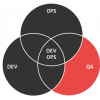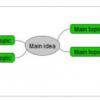 |
DevOps: Collaboration with a Purpose Development, operations, and QA have long recognized the importance of coexistence, but they've still had weak or unbalanced relationships. DevOps emphasizes collaboration, rejecting the "us versus them" mentality. Every department needs information, feedback, and support from every other department, helping everyone see how they enable each other.
|
|
 |
Leverage Containers to Create Simulated Test Environments on Demand Adopting service virtualization can allow organizations to achieve more effective software development and testing by removing traditional test environment bottlenecks. Integrating service virtualization within the continuous delivery pipeline using containerization helps teams reach the level of flexibility required by today's competitive markets.
|
|
 |
The Value of Making Your Data Sources Reusable across Test Automation Tools Many automation tools have a mechanism for storing data used in their test scripts. Typically, the specifics of this mechanism is different across tools, making it difficult to use this data outside the tool itself. Using an external, reusable data source allows organizations to avoid the cost of migrating or duplicating existing data, thereby future-proofing their frameworks.
|
|
 |
Testing in Production: A Double-Edged Sword Testing in production gives more realistic opportunities to test, increases application transparency between the core product team and users, and supports the idea of continuous development through continuous testing. It's a good technique to embrace in your testing process—but it should not be entered into unprepared. Learn the advantages and pitfalls here.
|
|
 |
Testing the Unexpected: A Shift Right in DevOps Testing When it comes to testing in DevOps, more than simple regression checking can be automated. By shifting right in the lifecycle and testing in production, you can analyze the undefined, unknown, and unexpected by relying on real traffic and unpredictable test input. With shorter implementation and release cycles, testing and production come closer together.
|
|
 |
DevOps: Changing the Software Testing Game The DevOps movement promises to be as influential as project management and good requirements ever were in programming and testing. By combining ops (deploys, monitoring) with programming (automated builds, automated virtual servers) and testing (risk management), we get something that is more than the sum of its parts.
|
|
 |
7 Test Automation Requirements for Higher Software Quality An advanced, efficient test automation platform, combined with a more systematic and comprehensive architecture, can help boost quality assurance operations to a whole new level. In order to best maximize a software product’s reliability, consider these seven requirements for your test automation efforts.
|
|
 |
Containers: A Tester's Friend or Foe? Containers support the timely delivery of a quality software application. However, the change to a DevOps process involving containers will require testers to adapt to this new, more agile environment. What does that mean for testers and the work they do? Here's how testers can embrace these changes, containers, and DevOps.
|
|
 |
Testers: An Integral Part of the DevOps Team Building innovative software faster and better is imperative to an organization’s success, so it makes sense to take advantage of DevOps. But what some teams fail to consider is that testing is a crucial part of the process. Without a “test early and often” mentality, DevOps would only be able to release software faster—not better.
|
|
 |
Using Mind Maps to Create Comprehensive Test Plans in Your ALM Mind maps work well for planning the test strategy and monitoring project status. Mind-mapping software makes all this easy, and the visual presentation keeps everyone in the loop. Ritinder Kaur shows how mind maps can communicate ideas clearly and help you execute them exactly to create a comprehensive test plan.
|
|

